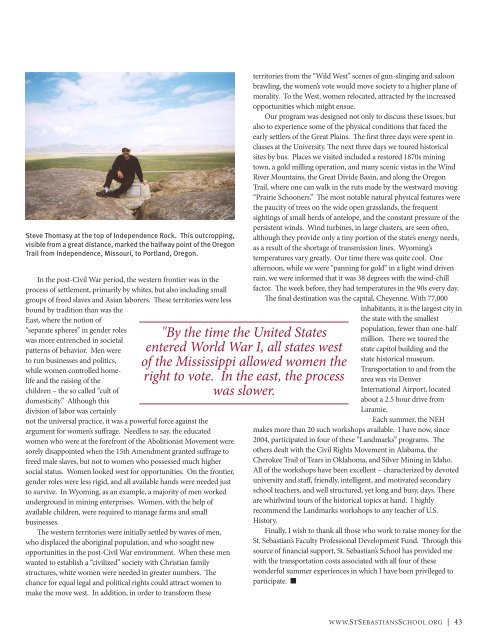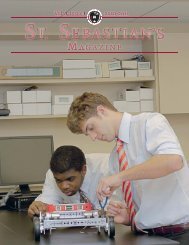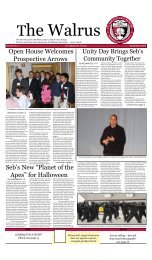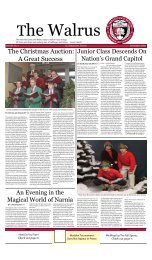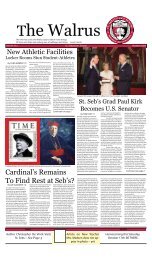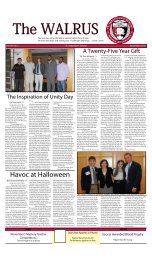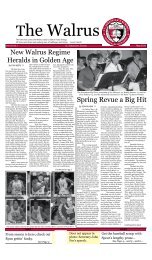ST SEBASTIAN’S
Issue I - St. Sebastian's School
Issue I - St. Sebastian's School
- No tags were found...
You also want an ePaper? Increase the reach of your titles
YUMPU automatically turns print PDFs into web optimized ePapers that Google loves.
Steve Thomasy at the top of Independence Rock. This outcropping,<br />
visible from a great distance, marked the halfway point of the Oregon<br />
Trail from Independence, Missouri, to Portland, Oregon.<br />
In the post-Civil War period, the western frontier was in the<br />
process of settlement, primarily by whites, but also including small<br />
groups of freed slaves and Asian laborers. These territories were less<br />
bound by tradition than was the<br />
East, where the notion of<br />
“separate spheres” in gender roles<br />
was more entrenched in societal<br />
patterns of behavior. Men were<br />
to run businesses and politics,<br />
while women controlled homelife<br />
and the raising of the<br />
children – the so called “cult of<br />
domesticity.” Although this<br />
division of labor was certainly<br />
not the universal practice, it was a powerful force against the<br />
argument for women’s suffrage. Needless to say, the educated<br />
women who were at the forefront of the Abolitionist Movement were<br />
sorely disappointed when the 15th Amendment granted suffrage to<br />
freed male slaves, but not to women who possessed much higher<br />
social status. Women looked west for opportunities. On the frontier,<br />
gender roles were less rigid, and all available hands were needed just<br />
to survive. In Wyoming, as an example, a majority of men worked<br />
underground in mining enterprises. Women, with the help of<br />
available children, were required to manage farms and small<br />
businesses.<br />
The western territories were initially settled by waves of men,<br />
who displaced the aboriginal population, and who sought new<br />
opportunities in the post-Civil War environment. When these men<br />
wanted to establish a “civilized” society with Christian family<br />
structures, white women were needed in greater numbers. The<br />
chance for equal legal and political rights could attract women to<br />
make the move west. In addition, in order to transform these<br />
"By the time the United States<br />
entered World War I, all states west<br />
of the Mississippi allowed women the<br />
right to vote. In the east, the process<br />
was slower.<br />
territories from the “Wild West” scenes of gun-slinging and saloon<br />
brawling, the women’s vote would move society to a higher plane of<br />
morality. To the West, women relocated, attracted by the increased<br />
opportunities which might ensue.<br />
Our program was designed not only to discuss these issues, but<br />
also to experience some of the physical conditions that faced the<br />
early settlers of the Great Plains. The first three days were spent in<br />
classes at the University. The next three days we toured historical<br />
sites by bus. Places we visited included a restored 1870s mining<br />
town, a gold milling operation, and many scenic vistas in the Wind<br />
River Mountains, the Great Divide Basin, and along the Oregon<br />
Trail, where one can walk in the ruts made by the westward moving<br />
“Prairie Schooners.” The most notable natural physical features were<br />
the paucity of trees on the wide open grasslands, the frequent<br />
sightings of small herds of antelope, and the constant pressure of the<br />
persistent winds. Wind turbines, in large clusters, are seen often,<br />
although they provide only a tiny portion of the state’s energy needs,<br />
as a result of the shortage of transmission lines. Wyoming’s<br />
temperatures vary greatly. Our time there was quite cool. One<br />
afternoon, while we were “panning for gold” in a light wind driven<br />
rain, we were informed that it was 38 degrees with the wind-chill<br />
factor. The week before, they had temperatures in the 90s every day.<br />
The final destination was the capital, Cheyenne. With 77,000<br />
inhabitants, it is the largest city in<br />
the state with the smallest<br />
population, fewer than one-half<br />
million. There we toured the<br />
state capitol building and the<br />
state historical museum.<br />
Transportation to and from the<br />
area was via Denver<br />
International Airport, located<br />
about a 2.5 hour drive from<br />
Laramie.<br />
Each summer, the NEH<br />
makes more than 20 such workshops available. I have now, since<br />
2004, participated in four of these “Landmarks” programs. The<br />
others dealt with the Civil Rights Movement in Alabama, the<br />
Cherokee Trail of Tears in Oklahoma, and Silver Mining in Idaho.<br />
All of the workshops have been excellent – characterized by devoted<br />
university and staff, friendly, intelligent, and motivated secondary<br />
school teachers, and well structured, yet long and busy, days. These<br />
are whirlwind tours of the historical topics at hand. I highly<br />
recommend the Landmarks workshops to any teacher of U.S.<br />
History.<br />
Finally, I wish to thank all those who work to raise money for the<br />
St. Sebastian’s Faculty Professional Development Fund. Through this<br />
source of financial support, St. Sebastian’s School has provided me<br />
with the transportation costs associated with all four of these<br />
wonderful summer experiences in which I have been privileged to<br />
participate. ■<br />
WWW.<strong>ST</strong>SEBA<strong>ST</strong>IANSSCHOOL.ORG | 43


